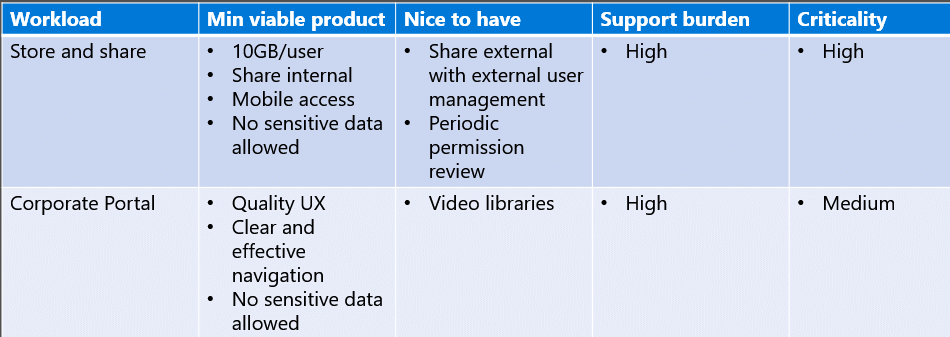Planning Your SharePoint Service Delivery in the Era of Office 365


Decisions, Decisions…
 SharePoint pros are used to making decisions when new versions of the platform come out. Every few years, you decide if you are going to upgrade to the new version of SharePoint and then plan accordingly. The complexity, cost and hassle of a migration is balanced against potential benefits of the updated offering like better stability, scalability and productivity. Previously, there were really only a few potential paths you could take— you could pass on the new version entirely, you could use the new version for “net new” sites and leave legacy content where it sat, or you could commit fully to getting your SharePoint workloads moved onto the new version. Many of you are probably going through this assessment right now as we move ever closer to the general availability of SharePoint 2016. But things are different this time around. The maturity and power of Microsoft’s Office 365 platform adds another wrinkle to this decision-making process. If you are going to migrate, where do you migrate to? SharePoint 2016 certainly has some compelling new security, reliability and productivity benefits, but some of the most exciting enhancements Microsoft has turned out over the last few years remain exclusive to Office 365. The prospect that migrating to SharePoint Online means you may never have to migrate your SharePoint content ever again is also certain to raise an eye from even the most conservative SharePoint professional. In this post, I’ll offer some tips to help you navigate this decision and get you thinking about the path that might be right for you.
SharePoint pros are used to making decisions when new versions of the platform come out. Every few years, you decide if you are going to upgrade to the new version of SharePoint and then plan accordingly. The complexity, cost and hassle of a migration is balanced against potential benefits of the updated offering like better stability, scalability and productivity. Previously, there were really only a few potential paths you could take— you could pass on the new version entirely, you could use the new version for “net new” sites and leave legacy content where it sat, or you could commit fully to getting your SharePoint workloads moved onto the new version. Many of you are probably going through this assessment right now as we move ever closer to the general availability of SharePoint 2016. But things are different this time around. The maturity and power of Microsoft’s Office 365 platform adds another wrinkle to this decision-making process. If you are going to migrate, where do you migrate to? SharePoint 2016 certainly has some compelling new security, reliability and productivity benefits, but some of the most exciting enhancements Microsoft has turned out over the last few years remain exclusive to Office 365. The prospect that migrating to SharePoint Online means you may never have to migrate your SharePoint content ever again is also certain to raise an eye from even the most conservative SharePoint professional. In this post, I’ll offer some tips to help you navigate this decision and get you thinking about the path that might be right for you.
Pros and Cons
It wouldn’t be an Office 365 blog post without a section on “pros and cons” of the cloud. We won’t rehash too much of the conventional wisdom here, but suffice to say that classic “pros” of moving to Office 365 include:
- Rapid access to new features and capabilities that Microsoft adds to the Office 365 service every month
- A financially backed, 99.9% uptime SLA that is as good or better than what almost all organizations have for their on-premises SharePoint service
- Significant reduction in the management and maintenance of the infrastructure to support SharePoint
- Shift from paying for software as a high-dollar, lump-sum capital expense to a monthly, usage-based operational expense
Common “cons” that you will hear around the Microsoft Cloud are:
- Regulatory or privacy concerns about storing data in a multitenant cloud service
- Loss of control about when to roll out changes or new features that may affect end users
- Reliance on stable and fast internet access for all users in the organization
- Complexity of integrating and synchronizing on-premises identity stores like Active Directory (AD) with Azure AD to support Office 365 logins
Obviously, if any of the cons listed above are blockers for you, those blockers need to be addressed before you can actually move forward with an Office 365 deployment.
Making it a Business Decision
 While there is a lot of technology in the equation, the real drivers for considering the move of some or all of your SharePoint workloads to Office 365 are really best taken as a business decision. By that, I don’t mean that the decision is made by the business, though they are certainly important stakeholders to consider and may be vocal in their opinions. Rather, it can be useful think about yourself as a service provider to the business (which is what you are, of course) and ask yourself a couple of basic questions. Start by breaking up your overall SharePoint offering into specific workloads that you want to use SharePoint and OneDrive for Business to satisfy. What are those workloads? In most organizations, they look something like this:
While there is a lot of technology in the equation, the real drivers for considering the move of some or all of your SharePoint workloads to Office 365 are really best taken as a business decision. By that, I don’t mean that the decision is made by the business, though they are certainly important stakeholders to consider and may be vocal in their opinions. Rather, it can be useful think about yourself as a service provider to the business (which is what you are, of course) and ask yourself a couple of basic questions. Start by breaking up your overall SharePoint offering into specific workloads that you want to use SharePoint and OneDrive for Business to satisfy. What are those workloads? In most organizations, they look something like this:
- Corporate intranet portal
- Personal productivity and document storage
- Team collaboration
- Social collaboration
- Custom application platform
What you are really doing here is defining what services you will be offering to the business. Once this list is defined, make another pass through it and identify the “minimum viable product” (MVP) for each workload. Example: What is the minimum amount of storage each user will require? Do you require the ability to synchronize personal files to users’ laptops? For your application platform needs, do you need to support older, legacy SharePoint-based applications? By defining the MVP of each workload, you will set the base level of functionality you require. As you can see, right off the bat you may find that Office 365 has capabilities and limitations that lend themselves more to some workloads than others. Now go ask some more questions about each workload: What are “nice to have” features for each that you see a need for or about which you get requests from the business? Your ability to truly be a strategic enabler of the business is in part based on these kinds of transformative capabilities. Ask what the criticality of each workload is, and then match that to the 99.9% SLA that Microsoft provides and your own internal uptime metric. Consider the support burden of each workload, both in terms of equipment, storage, and infrastructure costs as well as man hours spent maintaining the service. In the end, you will have a table that looks something like this:  Once completed, let this be your blueprint for building your service offering for SharePoint. Like any service provider, you are going to choose the right tools and foundation for the offerings you need to provide to the business, today and in the future. Workloads will present themselves as good Office 365 candidates if they have a high support burden. If you have good internet connectivity for all users, then workloads with high criticality also are good Office 365 candidates, but if not, and internet access is unreliable, you may want to keep those workloads on premises. For workloads where productivity and innovation can add significant value, like team collaboration, Office 365 Groups and Planner may be the killer features that make the Microsoft Cloud the right place for that type of collaboration. But for your application platform workload, needing to support legacy SharePoint applications may mean those workloads will stay on premises for the foreseeable future.
Once completed, let this be your blueprint for building your service offering for SharePoint. Like any service provider, you are going to choose the right tools and foundation for the offerings you need to provide to the business, today and in the future. Workloads will present themselves as good Office 365 candidates if they have a high support burden. If you have good internet connectivity for all users, then workloads with high criticality also are good Office 365 candidates, but if not, and internet access is unreliable, you may want to keep those workloads on premises. For workloads where productivity and innovation can add significant value, like team collaboration, Office 365 Groups and Planner may be the killer features that make the Microsoft Cloud the right place for that type of collaboration. But for your application platform workload, needing to support legacy SharePoint applications may mean those workloads will stay on premises for the foreseeable future.
A Foot in Each Camp
 If you are like many people we talk to, you may very well find yourself in a position where some workloads are ideal for the cloud and others need to stay on premises. This is not a problem. Starting with SharePoint 2013, and even more so with SharePoint 2016, Microsoft is heavily investing in ways of wiring up an on-premises SharePoint deployment with Office 365 to reduce confusion for users and provide a more seamless experience. If you are on a version of SharePoint prior to 2013, and you planning on moving some but not all workloads to Office 365, you will want to seriously consider upgrading your on-premises version to gain the benefit of the new hybrid improvements around OneDrive for Business, Yammer/Newsfeeds, and integrated search. Hybrid SharePoint deployments are often the way to get the best of both worlds – control where you need it for sensitive data or legacy processes that need to be maintained, and rapid access to the latest productivity capabilities that Microsoft adds to Office 365. Regardless of where your decision ends, you can have the peace of mind that your decision was made based off a clear understanding and analysis of your requirements and the best available tools and options to support them.
If you are like many people we talk to, you may very well find yourself in a position where some workloads are ideal for the cloud and others need to stay on premises. This is not a problem. Starting with SharePoint 2013, and even more so with SharePoint 2016, Microsoft is heavily investing in ways of wiring up an on-premises SharePoint deployment with Office 365 to reduce confusion for users and provide a more seamless experience. If you are on a version of SharePoint prior to 2013, and you planning on moving some but not all workloads to Office 365, you will want to seriously consider upgrading your on-premises version to gain the benefit of the new hybrid improvements around OneDrive for Business, Yammer/Newsfeeds, and integrated search. Hybrid SharePoint deployments are often the way to get the best of both worlds – control where you need it for sensitive data or legacy processes that need to be maintained, and rapid access to the latest productivity capabilities that Microsoft adds to Office 365. Regardless of where your decision ends, you can have the peace of mind that your decision was made based off a clear understanding and analysis of your requirements and the best available tools and options to support them.
Join us in AvePoint’s Cloud Arcade
For our strategy guide to unlocking the full potential of Office 365, be sure to check out AvePoint’s Cloud Arcade. You can also learn more about making the right decisions when choosing your cloud, on-premises, or hybrid deployment by watching my on demand webinar, AvePoint’s Cloud Arcade Presents: Mastering the Cloud Game. 

John Peluso is AvePoint’s Chief Technology Officer. In this role, he aligns the Company’s technology and product roadmaps to grow AvePoint’s market share, and accelerate the ideation, development, and launch of innovative software products tailored to anticipate customer needs. Prior to this role, John held multiple leadership roles over his 13-year tenure at AvePoint, including Chief Product Officer, SVP of Product Strategy, Director of Education, and Chief Technology Officer, Public Sector.
Before joining AvePoint, John served in a variety of technology and business roles at New Horizons Northeast and New Horizons of Central and Northern NJ. He earned his undergraduate degree from The New School.


